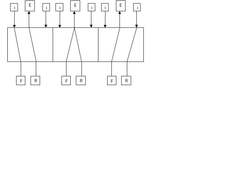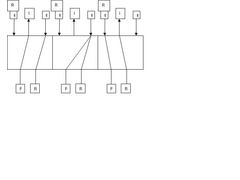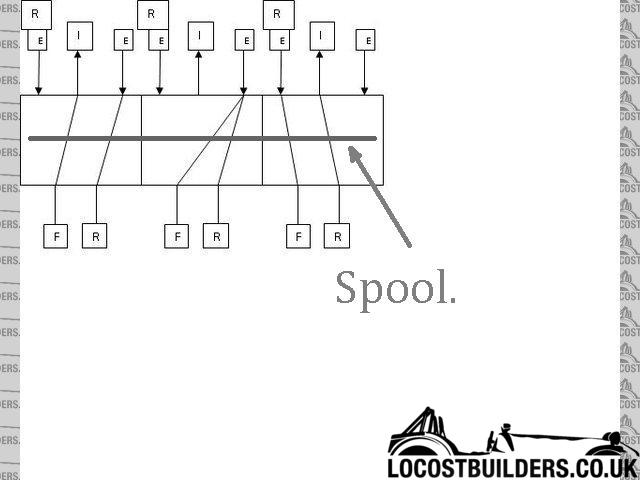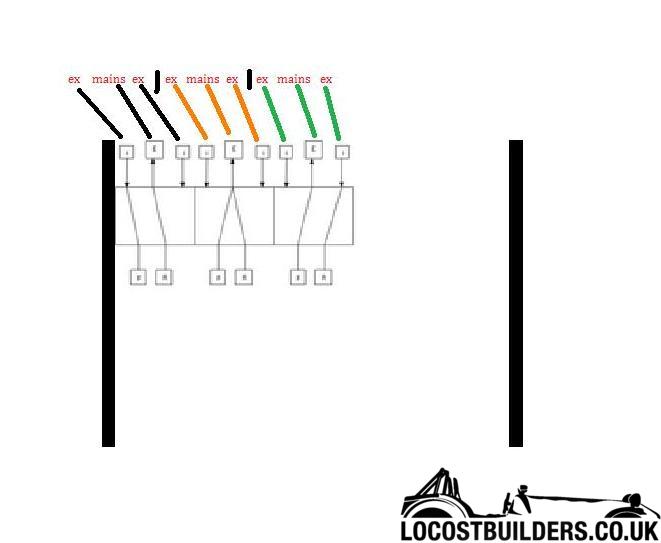hughpinder
|
| posted on 3/12/12 at 07:24 PM |

|
|
Also: Don't forget to consider your failure modes - air pressure fail, power fail and cylinder sticking modes - If the wire drops off one of
your signals what will you get - not just the driving ones, but the feedbacks too. Consider the cases for each signal, from all possible combinations
- you don't want it to select 1st when you're just sat there, or when you're flat out in top. The same with the air fail. For
preference, you probably want it to 'stayput' I would guess, assuming you still have a clutch to dip, as you wouldnt want to loose all
drive half way round a bend/in the fast lane of the M1 during rush hour..
Also, remember pneumatics mean you are dealing with a compressible fluid, so you could get some nasty states if a cylinder jams.
I am watching with interest to see how it all turns out!
Regards
Hugh
|
|
|
|
|
TPG
|
| posted on 3/12/12 at 07:32 PM |

|
|
Another one to chuck in is a double ended cylinder. More atuned to straight forward and back,that is a bike change. With the use of internal or
external springs you can have a "Centre off" and via a linkage or signalling, a push or pull on the lever.

..Which was nice..
|
|
|
v8kid
|
| posted on 3/12/12 at 09:03 PM |

|
|
quote:
Originally posted by phelpsa
quote:
Originally posted by v8kid
Ta for the input and I accept what you are saying sometimes the truth is a bit negative- however... The change is slow manually so it would not be
surprising if the pneumatic change was around the same speed.
Disengagement does not have the same limitations I can speed that up as is the cross box movement its the re-engagement that would be tricky.
So you reckon I have to build the force up progressively on the second cylinder engagement. Perhaps I could do that by blending two regulators one
high pressure and one low pressure brinf the low one in straight away to take up slack and put say 25% force on and then connect high pressure through
a metering orifice. Not ideal but it could work and is better than being slow 
Worth a try?
Cheers!
[Edited on 3-12-12 by v8kid]
Anything that could get you closer to how a manual syncro gearbox is normally operated would be best IMO, ie building up pressure on the syncro until
the gear speeds match and the dog 'falls' in.
Using staged actuation might be a solution, but its one of these things that isn't repeatable so a bit difficult to set up. Its a topic that
interests me so i'm gonna keep thinking, if I think of anything i'll put it on here.
And you can see I really need it! Please do give input I'd rather be told I'm on the wrong track than rush in where angels....
You'd be surprised how quickly the sales people at B&Q try and assist you after ignoring you for the past 15 minutes when you try and start a
chainsaw
|
|
|
v8kid
|
| posted on 3/12/12 at 09:05 PM |

|
|
quote:
Originally posted by TPG
Just a thought. Remember to get sol/sol operated 5/2 valves. The one your looking at needs a constant 12v to remain in state (It is a sol/spring) If
you remove the voltage it will switch back. You can get them to move both ways at a solenoid signal I.e a sol/sol unit.
[Edited on 3/12/12 by TPG]
That one was like a land mine waiting to catch me - Ta for the heads up I had nearly ordered the blessed thinks!
You'd be surprised how quickly the sales people at B&Q try and assist you after ignoring you for the past 15 minutes when you try and start a
chainsaw
|
|
|
v8kid
|
| posted on 3/12/12 at 09:11 PM |

|
|
quote:
Originally posted by TPG
Another one to chuck in is a double ended cylinder. More atuned to straight forward and back,that is a bike change. With the use of internal or
external springs you can have a "Centre off" and via a linkage or signalling, a push or pull on the lever.

Nice idea but I'm wary of springs they tend to have a mind of their own.
However I can see some merit here the trouble I'd have to consider the springs inside the box - there will be an energy transfer between the
external actuating springs and the selector springs - it could work in my favour if I get the sums right but def against me if I get them wrong. Or if
they change. Or if the "stickiness" changes.
Sorry too difficult!
Cheers!
You'd be surprised how quickly the sales people at B&Q try and assist you after ignoring you for the past 15 minutes when you try and start a
chainsaw
|
|
|
v8kid
|
| posted on 4/12/12 at 02:06 PM |

|
|
Ok I think I need one of these. The center position is where the action is completed and the piston is exhausted so that I do not have a constant
pressure on the selector forks
 
valve 1
However I'd like to have one of the back to back pistons allocated to engaging the gear and to make sure I don't hammer it home too fast
I'd like to have a metering needle valve on the exhaust but that means swaping inlet and exhaust ports and connecting the valve body the other
way round like this
 
valve 2
Are there any problems doing it this way? Do valves like this exist?
I've got to work for a few days so I'll let it stew in my mind 
Thanks for all your help guys.
Cheers!
You'd be surprised how quickly the sales people at B&Q try and assist you after ignoring you for the past 15 minutes when you try and start a
chainsaw
|
|
|
TPG
|
| posted on 4/12/12 at 06:29 PM |

|
|
"Do these exist?" No ( In my experience any way). What you've drawn there is a 5/3 valve which does exist but the centre position
layout or option isn't available off the shelf. You could make that happen with extra 2/2 or 3/2 valves onto the 5/3 valve.

I have drawn a line through the valve drawing. This shows the valve spindle or spool. Have a gander on't the google for a 5/2 or 5/3 valve
service kit. Hydraulic or air. They are very similar in principle. Here is a link to some diagrams of common stuff
http://www.solenoidvalvesuk.com/solenoidsymbols.asp
..Which was nice..
|
|
|
TPG
|
| posted on 4/12/12 at 07:08 PM |

|
|
Hopefully this'll make it a bit clearer. The input side ports can't change use. the exhausts are always exhausts and the mains in is
always mains in. You have it shown as the ram having both ends connected to the mains in one position. If you can image a 3/2 valve on the mains in
side (No1 port) you could join them together outside of your 5/2 valve.

..Which was nice..
|
|
|
MarcV
|
| posted on 5/12/12 at 12:43 PM |

|
|
Not a pneumatics expert at all, but do know a bit on this kind of work.
First of all it would by far be the easiest if no clutch control is involved (ie do it with your own foot). Then a standard street H-box has two
movements, one to select the relevant shift fork (1-2, 3-4 etc.) and one to operate this fork.
To operate the shift fork, you might be best off with using a pressure control valve. This would excert a certain force on the fork which engages the
synchro at first and should then drop into gear. You will need feedback to verify this so you know when you can release the clutch again.
The selector movement can be made by position valves but again feedback is needed such that engagement of the shift fork is withheld until the proper
fork is selected.
What would you like to achieve. Manual clutch control makes the automatic change useless (in my opinion) and heavy and costly all at the same time.
Not using the clutch when changing gear means that you either need a throttle blipper of some sort and synchronize this with the gearchange or you
need to change the engine revs through the synchro which will make it wear out rather quickly.
As mentioned before you will need to think about safety as well. The car should not be startable when the box is in gear and clutch not actuated. The
clutch should also not actuate itself when brakes are not applied. It should not change gear when over- or underrev would result. Try to visualize
everything you do with the box (drive off, stop, actual driving, parking etc.) and be aware that most of this should now be programmed into a unit.
Also the things which can happen (sticky clutch or gear or actuators, sensor failure etc.)
Getting the forks to move is not the biggest challenge I'm afraid.
|
|
|
rf900rush
|
| posted on 5/12/12 at 02:06 PM |

|
|
Hi
Found the cylinders I mentioned
These are some of them
 
 
Martin
|
|
|
v8kid
|
| posted on 7/12/12 at 03:38 PM |

|
|
quote:
Originally posted by MarcV
Not a pneumatics expert at all, but do know a bit on this kind of work.
First of all it would by far be the easiest if no clutch control is involved (ie do it with your own foot). Then a standard street H-box has two
movements, one to select the relevant shift fork (1-2, 3-4 etc.) and one to operate this fork.
To operate the shift fork, you might be best off with using a pressure control valve. This would excert a certain force on the fork which engages the
synchro at first and should then drop into gear. You will need feedback to verify this so you know when you can release the clutch again.
The selector movement can be made by position valves but again feedback is needed such that engagement of the shift fork is withheld until the proper
fork is selected.
What would you like to achieve. Manual clutch control makes the automatic change useless (in my opinion) and heavy and costly all at the same time.
Not using the clutch when changing gear means that you either need a throttle blipper of some sort and synchronize this with the gearchange or you
need to change the engine revs through the synchro which will make it wear out rather quickly.
As mentioned before you will need to think about safety as well. The car should not be startable when the box is in gear and clutch not actuated. The
clutch should also not actuate itself when brakes are not applied. It should not change gear when over- or underrev would result. Try to visualize
everything you do with the box (drive off, stop, actual driving, parking etc.) and be aware that most of this should now be programmed into a unit.
Also the things which can happen (sticky clutch or gear or actuators, sensor failure etc.)
Getting the forks to move is not the biggest challenge I'm afraid.
Thanks for the input MarcV a nice summary. Yes there is quite a lot in this but if I chunk it down and solve it a bit at a time I have a better chance
of getting there. So I take in all your points but I'm happy that I will be able to solve them later one at a time.
Initially I will be using a manual foot clutch to simplify things and I'll add the safety points if required later. As i'm hoping to use a
raspberry Pi to do the control it should be doable.
How does a pressure control valve differ from a position control valve? Are you referring to metering needles on the exhaust port - you can see
I'm new to this 
Cheers!
You'd be surprised how quickly the sales people at B&Q try and assist you after ignoring you for the past 15 minutes when you try and start a
chainsaw
|
|
|
v8kid
|
| posted on 7/12/12 at 03:40 PM |

|
|
Thanks TPG I think I've got the basic principles of 5/2 valves now - looking back my question was a bit silly !
You'd be surprised how quickly the sales people at B&Q try and assist you after ignoring you for the past 15 minutes when you try and start a
chainsaw
|
|
|
v8kid
|
| posted on 7/12/12 at 03:42 PM |

|
|
Thanks for the offer of the cylinders Martin If my sums are right (big iff!) they look a bit on the big side
You'd be surprised how quickly the sales people at B&Q try and assist you after ignoring you for the past 15 minutes when you try and start a
chainsaw
|
|
|
v8kid
|
| posted on 7/12/12 at 04:01 PM |

|
|
OK I did some measurements this afternoon on the selector lever attached to the syncro forks. There is plenty room so I could shorten or extend the
lever to vary distance or force Just to be contrary I measured distance in mm and force in lb (cos that's what the spring balance reads)
N-1 25mm 10lb
N-2 30mm 8lb
N-3 15mm 5lb
N-4 20mm 8lb
Again for the selector that moves across gates
5-3/4 8mm 22lb
3/4 - 1/2 8mm 22lb
The travel is quite small here across the gate and I think I'll fit a longer lever. To give 30mm travel the force will be reduced to 6lb
I need to have loads in hand 'cos these forces were measured without the engine or box turning so say I double them and take the worst case to
standardise my cylinders to gives 30mm travel and 20lb. Metricate it and call it 10kgf to give another bit in hand.
A 32 mm bore cylinder with a 12mm pushrod has a piston area of pi/4*(D2-d2) = 6.9cm2 so I need an air pressure of 1.5kgfcm-2 or 21psi in real
engineering language.
That gives me loads of lattitude to increase pressure via a regulator if I need more oomph.
However how do I deal with the different stroke requirements N-3 only requires 15mm if I'm trying to give it 30mm will I bend the selectors?
Is there some sort of proprietary spring absorber I could fit?
Cheers!
[Edited on 7-12-12 by v8kid]
You'd be surprised how quickly the sales people at B&Q try and assist you after ignoring you for the past 15 minutes when you try and start a
chainsaw
|
|
|
v8kid
|
| posted on 11/12/12 at 03:57 PM |

|
|
Hmm this is more complex than I thought! The time taken to operate the gearchange affects not only the actuating piston but also the solenoid size. I
used the excellent Mead handbook (for dummies)
Here goes let me know if I get it wrong 
Cv (valve flow = area*stroke*pressure drop constant*compression factor/(time*29) easy all I have to do is find some numbers to plug in. I think
I'll revert to imperial if you don't mind 'cos that's how I think.
Area*stroke is easy 1.15" already worked out just converted to inches. Stroke is 1.2" Pressure drop constant and Compression factor from
look up table is 0.124 and 2.51 for a pressure drop of 2psi across the valve and 21psi output.
Now how fast should one third of a gearchange be i.e. the 2-n bit of a 2-n-n-3 change be? Well geartronics claim 62ms for a sequential box which is
roughly equilivent to two thirds of my change but we know synchro is going to be slower - say three times? so that gives me 0.1 seconds - handy eh!
Plugged in that gives a Cv of 0.15
So What? Well from another table I can find that for a cylinder bore of 1.3" and a cv of 0.15 I can expect a piston speed of 14" per
second so my 1.2" travel would take 0.085 seconds which is close enough to 0.1 I needed - or is it? On closer examination the last table was
based on 80psi not 23psi - rats.
On closer examination these valves and solenoids don't like low pressure much 'cos the stiction becomes more significant So redesign based
on 80 psi.
So I need to fit a smaller cylinder. A 25mm bore with a 10mm through rod would give 50lb thrust at 80 psi which seems more than adequate to me. I
think I can afford greater than 2psi drop this time with a higher starting pressure - say 5 psi
Replugging numbers Cv = 0.08 and a piston speed of 13.6"/s. so a 1.2" travel would take 0.09sec - BINGO! Only thing is we have assumed
instant acceleration of the piston but I guess Mead know what they are doing and have factored this in.
So now I've got my piston size correct for the force and time with plenty in hand - what about valves and connecting pipes?
Mead to the rescue - another look up table states that for a 1" bore the valve orifice dia needs to be 1/16" for 15"/s and rises to
37"/s for a 1/8" dia orifice. However I have a feeling that I will require interconnecting tubing greater than 1/8" but that's
for another day.
Cheers!
[Edited on 11-12-12 by v8kid]
You'd be surprised how quickly the sales people at B&Q try and assist you after ignoring you for the past 15 minutes when you try and start a
chainsaw
|
|
|
MarcV
|
| posted on 14/12/12 at 11:33 AM |

|
|
Could you elaborate a bit more on the reason for wanting this indirect shift? It seems starting with a foot operated clutch and just automated gear
change is a wise decision.
Do you have a cost-estimation of the setup you are now considering?
Reason for asking is that I would like to widen your view a bit. First of all, there are automated boxes on the road for quite a few years now. It
could be an option to adapt such a system to your use. Most are working hydraulically instead of pneumatically. I for one am trying to use a BMW SMG
box.
You could consider the actuator of the VW lupo 3L (search for lupo gangsteller). You can get a complete box with hydraulic pump, sensors and the
actuator for under Euro 1000.
If the option for different boxes is open (spending the cash on a known to work tranny instead of hoping to get it all working with the added
pneumatics on your current box), you might just consider a porsche or audi transaxle of double clutch type? This does have the hassle of needing to
operate the clutch, but in its basics is much simpler to control.
As far as I can tell from the topic so far, you would be using on-off valves. Then you surely need to take care not to overstress the synchros. The
hydraulic systems outlined above use proportional control valves (I'd guess they should be available in pneumatic version as well). Then there
are two main groups; proportional flow valves (flow proportional to control current) and proportional pressure valves (pressure proportional to
current). The latter is normally used for actuation of the shift forks. This way the electronics can account for transmission temperature (different
force on the synchros) change, different shifting programs etc.
Good luck, I will keep an eye on this topic!
|
|
|
on_eighty_runner
|
| posted on 15/12/12 at 07:39 PM |

|
|
Assuming it is a standard h type box the gear lever springs back centre Neutral.
If you consider how you operate manually you have 4 separate requirements.
Pull the lever Forward Back Left and Right.
Would suggest small rams of the correct travel spring return. Each with a flow restrictor to protect syncro
But you must do this in the correct sequence so you will need as a minimum a positive Left and Right travel limit switches and a not Forward not
backward on the other axis
These positive confirmations are then part of the sequence
Eg
To change from Second into Third is sequence
Release push Backward
Wait until in Centre
Release push Left
Confirm in Neutral (centre-centre)
Push Forward
Knowing where the end of the current activity is important to make the shift as fast as possible but not trying the next activity before it is safe/
appropriate to do so.
You do this yourself by feeling the gear lever restrictions but Rams are less sensitive.
The automation on this will be a job in itself.
You could use ladder logic but what about block changes?
Above are only the on/off controls of the gear change.
Clutch control from startup will be difficult, there are so many parameters to take into account
Dipping the clutch automatically and in effect dumping it again at the right revs may be ok though
What are your plans for automating all of this? If you are using a controller by others what inputs outputs are there?
I do think it is an interesting project. I do think you will have to write your own control system
F
Separately I have one of those French cars with the double clutch automated 6 speed and have been extremely impressed.
Changes up very early at light pedal but will drop a bunch of gears instantly with kickdown. Have never bothered with manual mode
[Edited on 15-12-12 by on_eighty_runner]
|
|
|
MarcV
|
| posted on 20/12/12 at 03:22 PM |

|
|
Gave it another thought and am wondering if pneumatic control of a standard clutch will ever work at all. Reasons for this are two fold;
- The clutch itself is very non lineair. Meaning that it could well be that over clutch arm travel the required force might not only increase, but
maybe decrease as well. The only real control you can have over pneumatics is the pressure meaning that you will not be able to control areas where
required force decreases for increased travel (it will continue to extend on its own past a certain point)
- The compressibility of air has a positive side which is compliancy (it will excert a force rather than movement), but there is a downside as well.
For proper control of anything you will have to account for things like static friction. Hydraulics will force something to move despite this static
friction, but pneumatics will need to overcome this friction by pressure which will cause a relatively large move once it 'breaks'. There
are control strategies for this (electronic throttle valves suffer greatly from this and are still very accurately controlled), but it will be more
difficult than by using hydraulics.
These might well be the biggest reasons for the commercial car builders to use hydraulics instead of pneumatics. If you would want to keep this path
open for future upgrade (clutch control in addition to the gear control), hydraulics might just be the way forward.
I am not at all criticising your work or intended route, just pointing out things to consider along the way.
Please do keep us updated.
|
|
|













